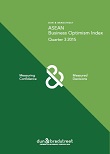ASEAN Region Poised for Increased Foreign Investment as China’s Economy Slows
As China’s once unparalleled economic growth begins to cool, investors are increasingly looking to diversify their assets in Southeast Asia. This trend has led to ASEAN becoming a recent hotbed for foreign investment: in 2014 alone, ASEAN member states combined for over US$2.3 trillion in total GDP.
Dun & Bradstreet’s ASEAN Business Optimism Index (BOI) is one of the leading economic indicators providing insight into the reasons behind this foreign investment, as measured by business sentiment for the quarter ahead through sales volume, net profit, selling price, new orders, inventory, and employment across various sectors and industries in ASEAN.
In this article we provide an overview of the promising trends major ASEAN markets as based on this Business Optimism Index.
China’s Stabilization
China has made headlines recently as its pivot to a stable, consumption-based economy has put increased pressure on its growth targets and internal markets. China’s recent devaluation of the Yuan and the rapid downturn of its Shanghai Composite Index in recent months have also forced some foreign investors to reevaluate their China and Southeast Asia strategies.
However, as Chris Devonshire-Ellis, Chairman of Dezan Shira, noted in a recent op-ed, this reevaluation from foreign investors has not led to an overall, mass exodus from the region, but rather to a strategic diversification of assets across Southeast Asia. Most notably, ASEAN has been gaining traction, led by strong growth in Vietnam.
ASEAN Rising
According to Dun & Bradstreet’s Business Optimism Index, overall business confidence in Vietnam soared from 27 percent to 43 percent last quarter. Five of the six optimism parameters also rose in Quarter 3 (Q3) of 2015, led by sales volume, net profit and new orders, each increasing nearly 30 percentage points. Vietnam’s ongoing strong growth and optimism is also driven primarily by its construction and manufacturing sectors: manufacturing is expected to grow by over 8 percent year-on-year for the first half of 2015, pushing Vietnam’s GDP to an expected 6.1% over the same period.
Singapore also remains one of the most consistent economies in ASEAN and Southeast Asia; business confidence in the wealthy city-state has remained steadily optimistic over the past two quarters. Optimism growth overall was very respectable across most of the optimism parameters, led by the service sector. The service sector in Singapore was the most hopeful sector last quarter, followed by the construction and manufacturing sectors. Manufacturing in particular staged a drastic turnaround in confidence from last quarter.
Long Term Look
Along with this recent growth seen in Vietnam and Singapore, ASEAN, as a whole, is also poised for more long-term, sustainable growth. A recent article from the Financial Review stresses the foreseen positive influences of ASEAN’s long-term growth trends, especially those directly affecting foreign investment. The rise of middle class households and Vietnam’s positive effect on the region are also highlighted.
Overall, foreign investors are witnessing a clear trend of a shift towards Asia’s secondary markets – a shift that seems poised to have clear long-term gains, even in congruence with neighboring China operations.
 The Business Optimism Index, released every quarter by Dun & Bradstreet, is considered a leading economic indicator for turning points in business activity and measuring business sentiment. The Index captures business expectations for the quarter ahead based on six parameters: sales volume, net profit, selling price, new orders, inventory, and employment. Sampling in the Index represents key business sectors including manufacturing, construction, wholesale, transportation, services, finance, mining and agriculture, according to their GDP contribution in each nation. The Business Optimism Index, released every quarter by Dun & Bradstreet, is considered a leading economic indicator for turning points in business activity and measuring business sentiment. The Index captures business expectations for the quarter ahead based on six parameters: sales volume, net profit, selling price, new orders, inventory, and employment. Sampling in the Index represents key business sectors including manufacturing, construction, wholesale, transportation, services, finance, mining and agriculture, according to their GDP contribution in each nation.
The ASEAN Business Optimism Index for Q3 2015 is out now and available as a complimentary download in the Asia Briefing Bookstore. |
 The Asia Sourcing Guide 2015
The Asia Sourcing Guide 2015
In this issue of Asia Briefing, we explain how and why the Asian sourcing market is changing, compare wage overheads, and look at where certain types of products are being manufactured and exported. We discuss the impact of ASEAN’s Free Trade Agreements with China and India, and highlight the options available for establishing a sourcing and quality control model in three locations: Vietnam, China, and India. Finally, we examine the differences in quality control in each of these markets.
The 2015 Asia Tax Comparator
In this issue, we compare and contrast the most relevant tax laws applicable for businesses with a presence in Asia. We analyze the different tax rates of 13 jurisdictions in the region, including India, China, Hong Kong, and the 10 member states of ASEAN. We also take a look at some of the most important compliance issues that businesses should be aware of, and conclude by discussing some of the most important tax and finance concerns companies will face when entering Asia.
 The Gateway to ASEAN: Singapore Holding Companies
The Gateway to ASEAN: Singapore Holding Companies
In this issue of Asia Briefing Magazine, we highlight and explore Singapore’s position as a holding company location for outbound investment, most notably for companies seeking to enter ASEAN and other emerging markets in Asia. We explore the numerous FTAs, DTAs and tax incentive programs that make Singapore the preeminent destination for holding companies in Southeast Asia, in addition to the requirements and procedures foreign investors must follow to establish and incorporate a holding company.
- Previous Article ASEAN and China Continue Negotiations on Expanded FTA
- Next Article Asian Highway to Link India, Myanmar, and Thailand









